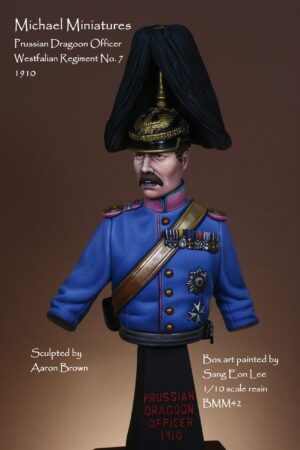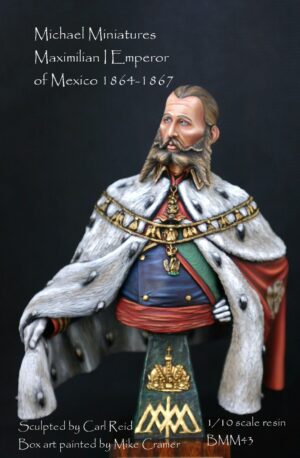Description
Archduke Charles of Austria
Battle of Aspern-Essling 1809
75mm mounted resin figure
Sculpted by: Paul Deheleanu
Box Art Painted by: Danilo Cartacci
Item: FMM01
Unpainted/assembly required
$129.95
Archduke Charles of Austria, Duke of Teschen (German: Erzherzog Karl von Österreich ). Born 5 September 1771, died 30 April 1847 was an Austrian field-marshal, the third son of emperor Leopold II and his wife Infanta Maria Luisa of Spain. He was also the younger brother of Francis II, Holy Roman Emperor. Despite being epileptic, Charles achieved respect both as a commander and as a reformer of the Austrian army. He was considered one of Napoleon’s most formidable opponents.
He began his career fighting the revolutionary armies of France. Early in the wars of the First Coalition, he saw victory at Neerwinden in 1793, before tasting defeat at Wattignies 1793 and Fleurus 1794. In 1796, as chief of all Austrian forces on the Rhine, Charles out-generaled Jean-Baptiste Jourdan at Amberg and Würzburg, and forced Jean Victor Marie Moreau to withdraw across the Rhine, and followed these victories with others at Zürich, Ostrach, Stockach, and Messkirch in 1799. He reformed Austria’s armies to adopt the nation at arms principle; in 1809, he went into the War of the Fifth Coalition with confidence and inflicted Napoleon’s first major setback at Aspern-Essling, before suffering a defeat at the bloody Battle of Wagram. Following Wagram, Charles saw no more significant action in the Napoleonic Wars.
As a military strategist, historians compare him to Arthur Wellesley, 1st Duke of Wellington, conservative, cautious, and competent. Charles was a study in contrasts. As a practitioner, He was flawless in executing complex and risky maneuvers of troops in the heat of battle, achieving brilliant victories in the face of almost certain defeat. He remains among Austria’s pantheon of heroes of the French Revolutionary and Napoleonic wars.
In 1806, Francis II (now Francis I of Austria) named the Archduke Charles, already a field marshal, as Commander in Chief of the Austrian army and Head of the Council of War. Supported by the prestige of being the only general who had proved capable of defeating the French, he promptly initiated a far-reaching scheme of reform, which replaced the obsolete methods of the 18th century. The chief characteristics of the new order were the adoption of the nation in arms principle and the adoption of French war organization and tactics. The army reforms were not yet completed by the war of 1809, in which Charles acted as commander in chief, yet even so it proved a far more formidable opponent than the old and was only defeated after a desperate struggle involving Austrian victories and large loss of life on both sides. Its initial successes were neutralized by the reverses of Abensberg, Landshut and Eckmuhl but, after the evacuation of Vienna, the Archduke won a strong victory at The Battle of Aspern-Essling but soon afterwards lost decisively at the Battle of Wagram. At the end of the campaign the archduke gave up all his military offices.
Charles died at Vienna on 30 April 1847. He is buried in tomb 122 in the New Vault of the Imperial Crypt in Vienna. An equestrian statue was erected to his memory on the Heldenplatz in Vienna in 1860. This figure is based on the statue.
Archduke Charles of Austria
Battle of Aspern-Essling 1809
75mm mounted resin figure
Sculpted by: Paul Deheleanu
Box Art Painted by: Danilo Cartacci
Item: FMM01
Unpainted/assembly required
You must be logged in to post a review.
 Prussian Dragoon 1910 BMM42
Prussian Dragoon 1910 BMM42
 Maximilian I Emperor of Mexico 1864-1867 BMM43
Maximilian I Emperor of Mexico 1864-1867 BMM43
Reviews
There are no reviews yet.